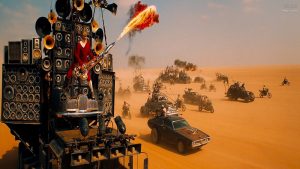With Furiosa: A Mad Max Saga hitting theaters soon, I figured now would be a good time to look back at the character’s origins in Mad Max: Fury Road. Like every other entry in the Mad Max franchise surprisingly enough, both Furiosa and Fury Road were released a substantially long time after the previous film and went through several major changes throughout development.
In the case of Fury Road specifically, it was initially conceived by director George Miller in 1987 before finally entering pre-production in 1998 with original series star Mel Gibson attached, only for the production to quickly spiral out of control in the wake of 9/11, the Iraq War, various location shoot issues, George Miller’s other priorities, and controversies surrounding Mel Gibson that made bringing him back a very bad idea.
Yet when Mad Max: Fury Road finally released in 2015, with Tom Hardy now taking the title role, it was almost immediately heralded as a masterpiece of action cinema, as well a surprisingly on-point feminist narrative. Though it only performed modestly well at the box office, making $380.4 million on a $185 million budget before marketing, its universal critical acclaim quickly turned it into a modern cultural touchstone. Does the film itself match that reputation? Let’s discuss.
Mad Max: Fury Road Plot
![Mad Max: Fury Road (2015) [Credit: Warner Bros. Pictures]](https://fwmedia.fandomwire.com/wp-content/uploads/2024/04/25082615/Mad-Max-Fury-Road-2015-300x120.jpeg) Mad Max: Fury Road (2015) [Credit: Warner Bros. Pictures]
Mad Max: Fury Road (2015) [Credit: Warner Bros. Pictures]
In a post-apocalyptic future devastated by nuclear war, Immortan Joe and his cult of War Boys are amongst the few left on Earth with access to cars, gasoline, and fresh water. Joe’s seond-in-command, Imperator Furiosa, is sent out on a supply run with the War Boys, only for her to betray them and escape alongside several women enslaved as Joe’s “breeders” and an imprisoned “blood bag” named Max Rockatansky.
From there, Furiosa, Max, and the freed women set out on the dangerous Fury Road to find the legendary Green Place, constantly navigating deadly terrain and outmaneuvering Joe and the War Boys along the way, only to discover that the mythologized paradise doesn’t exist. Though they are devastated by the realization, they soon realize that since the War Boys were chasing them down, their citadel and supplies have been left unguarded.
Our heroes quickly turn back the way they came, but Immortan Joe and the War Boys realize what they’re planning and catch back up with them. Immortan Joe and Furiosa’s rigs are neck-and-neck as Max takes down Joe’s son, Rictus Erectus, distracting Joe long enough for Furiosa to board Joe’s rig and kill him. After finally arriving at the citadel, Furiosa is celebrated as a hero and declared the new, hopefully fairer leader, as Max slips away into the crowd, headed to wherever the road takes him next.
Why Fury Road Works So Well
 A screengrab from the chase sequence of Mad Max Fury Road
A screengrab from the chase sequence of Mad Max Fury Road
When George Miller first conceptualized Fury Road, his goal was to create a Mad Max movie that felt “almost like a continuous chase.” And he certainly succeeded in that respect. The vast majority of Fury Road takes place ON the Fury Road, with bookends at the beginning and end taking place at the Citadel. And because every character is literally in motion for nearly the entire film, the narrative maintains a constant forward momentum even in its slower moments.
And on top of the action consisting of the some most impressive VFX work of the 2010s, both in terms of CGI and several practical stunts, the action, very smartly, always places the most important element in the center of the frame to ensure the audience is always able to keep track of what’s going on at any given time; a surprising rarity in the action genre. But Mad Max: Fury Road has far more going on under the hood (Get it?) than just an elaborate and expensive stunt show.
Fury Road is first and foremost a character piece between Max and Furiosa. Max himself, though he is the more stagnant and less talkative of the two, carries deep-seated trauma everywhere he goes, communicated through clever use of flashbacks, as well as Tom Hardy’s expressions and body language. Like in previous Mad Max films, particularly Road Warrior, Max’s stoic attitude and drifter mentality allow him to serve as a near-perfect audience POV character and anchor for the story, the proverbial straight man to the insane world around him; wanting to help but often having very little power to do so.
Meanwhile, Furiosa has spent most of her life as a pawn of Immortan Joe, counting down the days until she can escape to paradise; only to discover that her dream can never be realized and she has to find new purpose in leading the wives and eventually deprogramming the War Boys to hopefully build a better future. She goes through an intense, life-changing arc over the movie after already experiencing so much pain beforehand, as evidenced by both her prosthetic limbs and the fact that they’re releasing a whole prequel movie about her, and Charlize Theron’s performance sells it extremely well.
 Charlize Theron in Mad Max: Fury Road
Charlize Theron in Mad Max: Fury Road
Mad Max: Fury Road is simultaneously an adrenaline-fueled action spectacle with cool car flips and a flamethrower guitar and a deeply moving and thought-provoking commentary on authoritarianism and how society treats the marginalized, particularly women; accomplishing both goals without compromising either of them. It’s intense, it’s thrilling, it’s smart, it’s poignant, it more than holds up nearly a decade later and is without question one of the best action films ever made.





